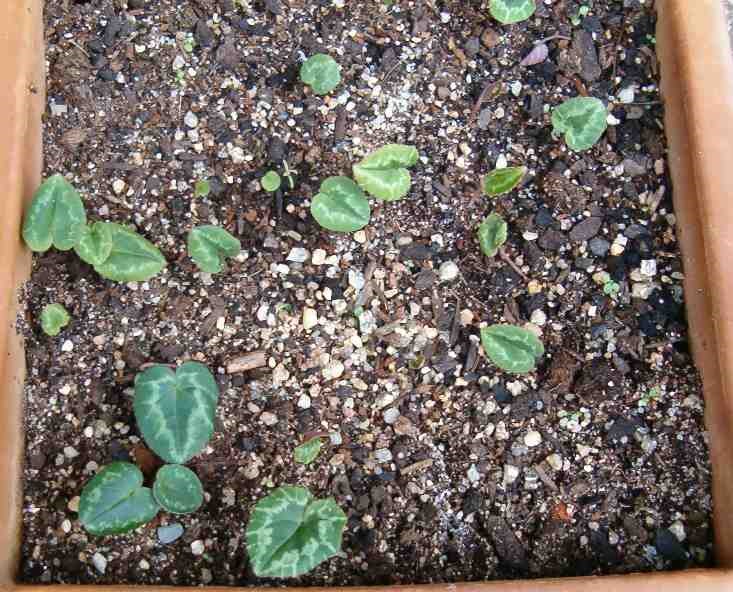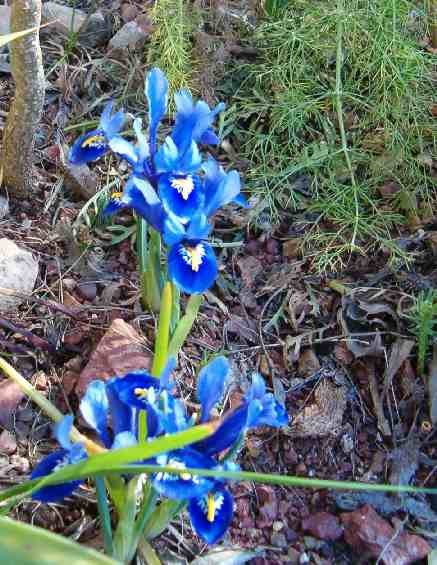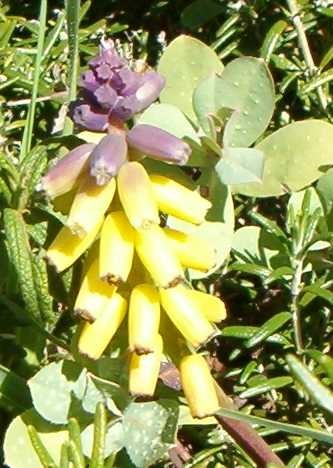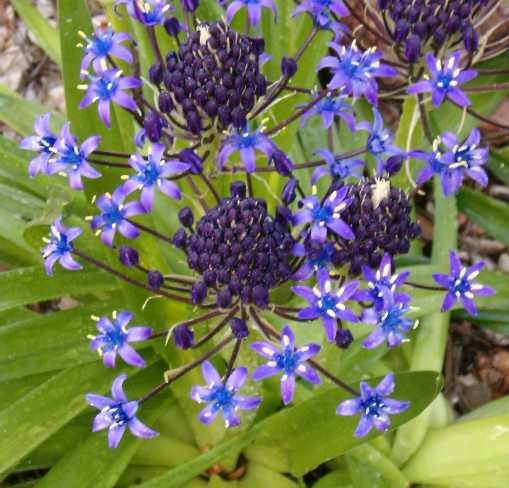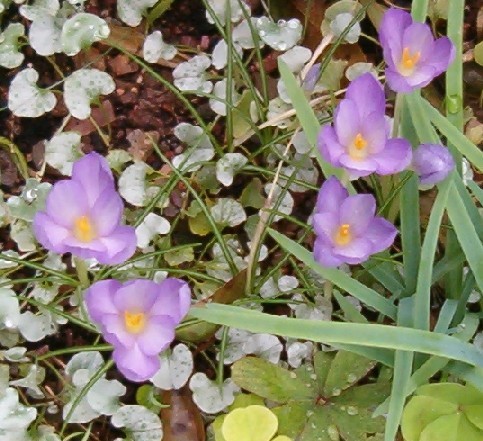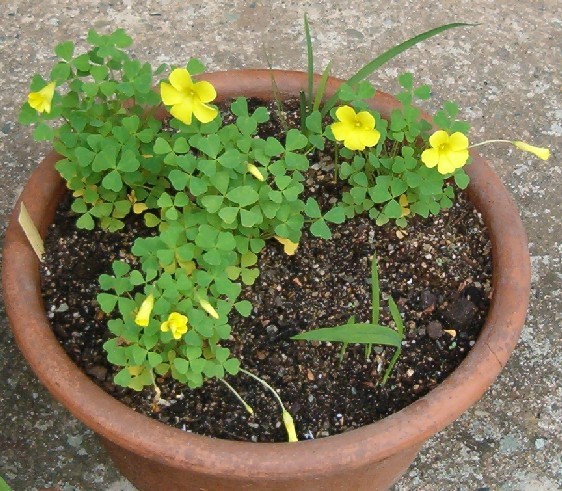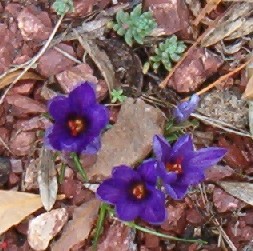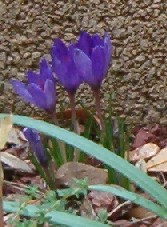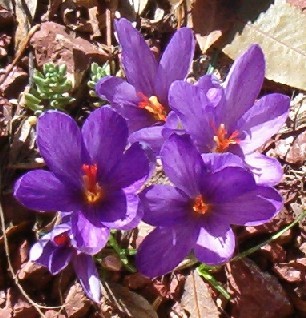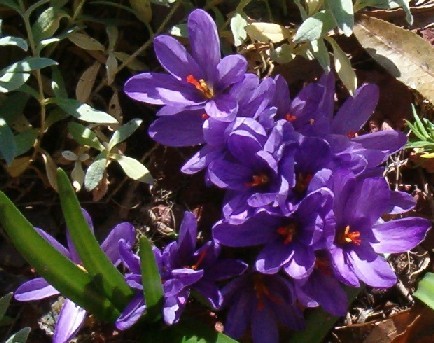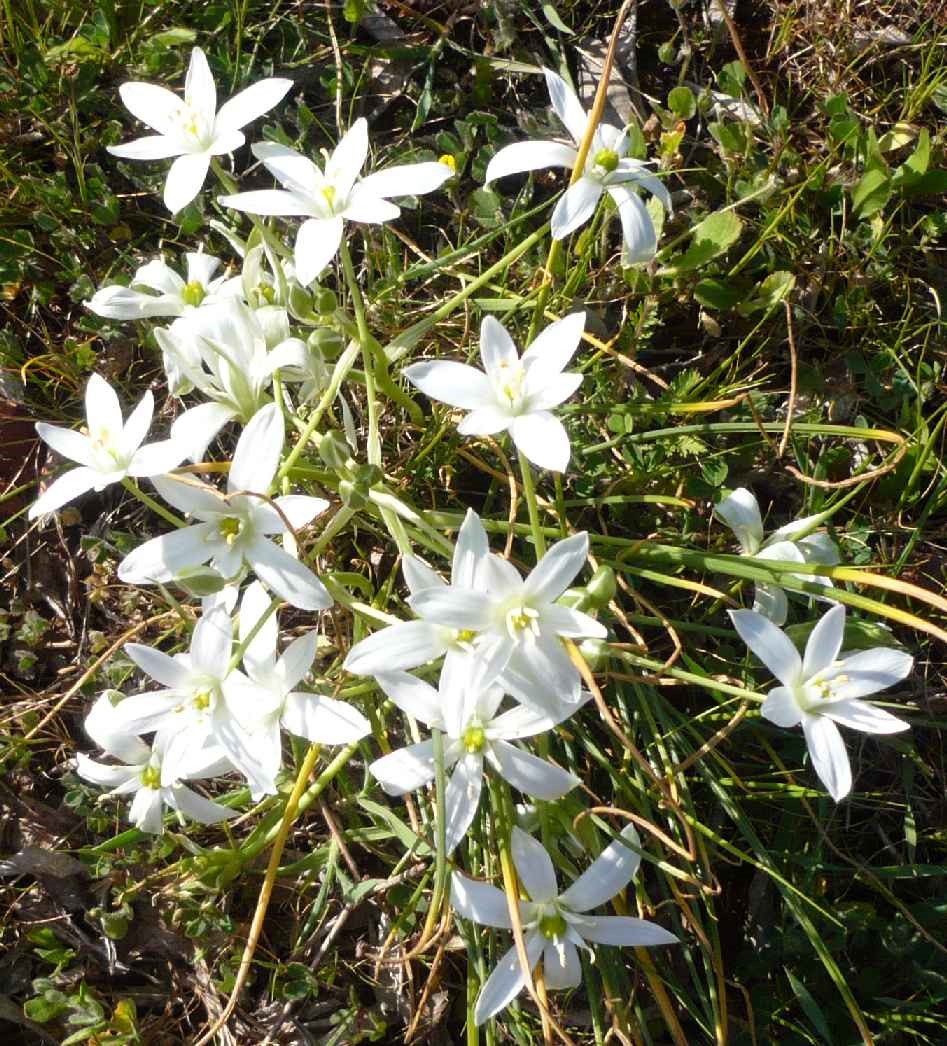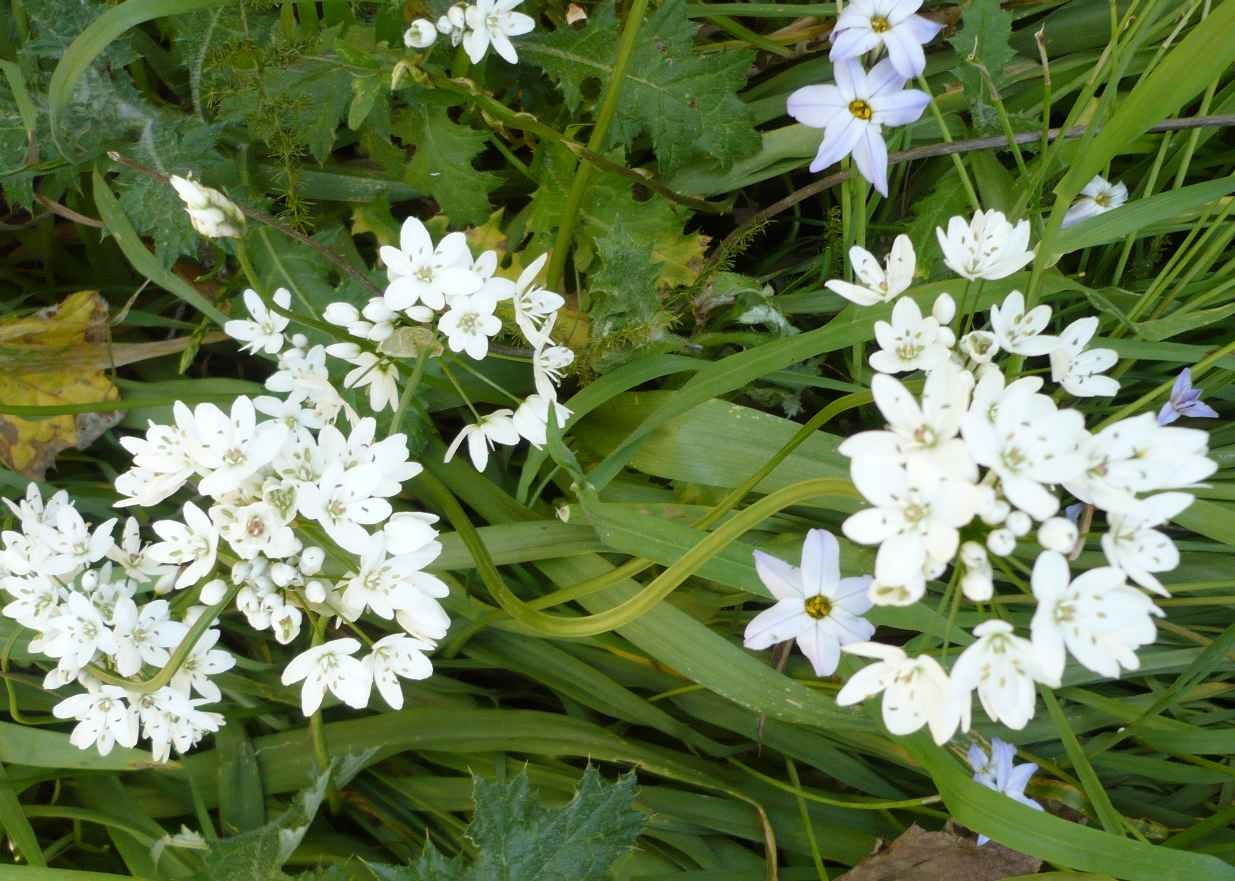|
List of bulbs used + results click here.
Pictures of bulbs: http://www.bulbsociety.org/gallery
and http://www.bulbargence.com
|
|
I really adore bulbs. Of course
there are favourites among them. Oxalis species
and hippeastrum with small flowers - from South
Africa - I think most attractive. Fortunately both do quite well in
these regions.
I would not be surprised if Oxalis rubra is a native
here. It starts flowering really early, sometimes March, goes on
right until June/July and has a second go at it from September
onwards. Contrary to what the name suggests the flowers are not red,
but pink with a darker heart. They may be used for cut flowers for a
short period. Lovely when put together with Dichondra 'Silver Falls'
.
If you have to pull it up for some reason you may find a long,
white carrot like root under the original bulb.
|
|
The
common varieties like Oxalis triangularis
en Oxalis deppei 'Iron Cross' do quite well in
these parts.The lovely purple leaves of oxalis triangularis
are sometimes gnawed by presumably snails or slugs. They
disappeared in 2007 though.
Worth while is Oxalis lasiandra. This one has
unusual, bronze coloured leaves, surprisingly shaped, like
small horse chestnut leaves. It has dark pink flowers.
I have been here for three
years now and come across oxalis lasiandra plants where I never put
them, so they must self seed.
Another
nice one: Oxalis bowiei. It flowers from August
onward, all its parts XXL. Freshly green, large leaves.
Flowers, also large, pink again. They do well outdoors here.
The corms look like garlic cloves. I got mine as a present
and I don't know where you may find it.
The other day I
saw it on a sales list of an English bulb grower: Broadleigh
gardens (sales@broadleighbulbs.co.uk),
but I have never tried them (yet).
I usually buy
my bulbs from Rita van der Zalm. The costs of
sending are more than compensated by the prices of the bulbs
themselves. Bulbs are quite expensive in France (as they are
in the UK). There are several mail order businesses in France.
I ordered their catalogues to satisfy my curiosity and ordered
in return. Some results were good, some poor.
See: miscellaneous
|
|
|
|
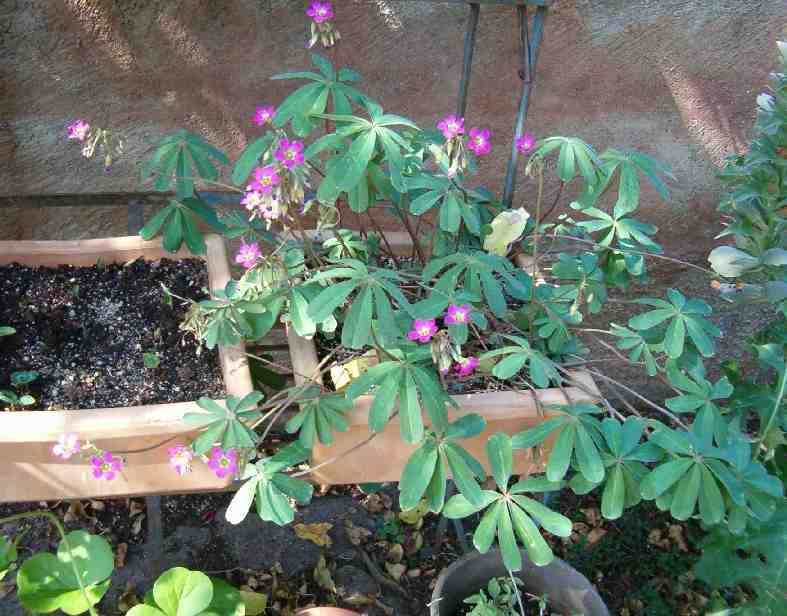
|
Oxalis lasiandra,
with its mini horse chestnut leaves flowers in summer.
They are lovely in a good pot but also do well in the
garden itself..
A great present for someone crazy about plants: a
handsome, smooth, preferably old, small, straight
earthenware pot (we call them Belgian pots) with one
or two oxalis lasiandra bulbs. The bulbs are for sale
at: Rita van de Zalm. www.ritavanderzalm.nl
|
|
| Oxalis
depressa looks nice,
but is invasive. Once planted you'll never get rid of them again.
There is a native type like that here in France, I don't know its
name. The bulbs look innocent, but they form long runners below the
soil with new bulblets at the ends. Those will flower after a year and are
quite pretty, pale pink. I was given it in a load of earth ... I try
to get them out using my little gadget mentioned on the
miscellaneous pages, preferably bulb and all, but to no avail. I
have been warned against Oxalis pes-caprae, yellow
flowered and lovely to the eye (I have seen it on photos only) which
seems to have been introduced to these parts. Only to be planted in
pots and beware of any seed. I am trying out blue Oxalis laciniata,
from the UK. So far I have never been successful with the gray leaved
species of oxalis like Oxalis adenophylla, so I don't
know how they will do. Their first year was not very promising ...
In January 2006 I hope to finally lay my hands on
Oxalis massoniana
from South Africa. Its flowers are burnt orange, wow! A gorgeous
photo is on page 100 in 'Bulbs for all Climates' - The
Australian Women's Weekly Garden Guides.
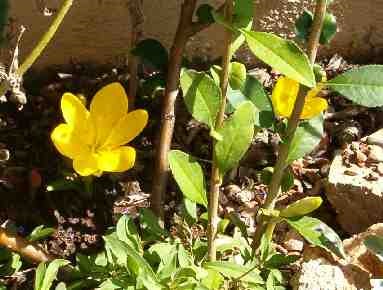 Sternbergia
lutea
Sternbergia
lutea
|
In France the bulbs
are hardly available. Someone might give you some, you
could buy at Rita's. They multiply easily.
|
|
There is not much to be told
about my love for small flowered hippeastrum at this moment
(autumn 2005). They do quite well in my garden without any
protection. But disappeared in 2007.
I only have a few but they are dormant now, with just the odd
leaf showing. One is called Hippeastrum sonatinii 'Veneto',
pinkish. Sonatinii stands for: with the smallest flowers, you
just have to know. Hippeastrum 'Topchoice',
bright red, I planted in a pot to start with. Three of them.
But they bore so many flowers that there was just no room, so
I planted them outdoors among euphorbia cypariassis which made
a lovely combination. Another one is unnamed and pale orange
with a greenish centre. This one has flowered every year so
far in early summer. Whenever I find out its name I'll publish
it.
|
|
Sternbergia
lutea is a native. It flowers in September with large,
'crocuses'. The French call it 'crocus jaune'. Later glossy,
dark green ribbon shaped leaves which are not bad!
|
|
|
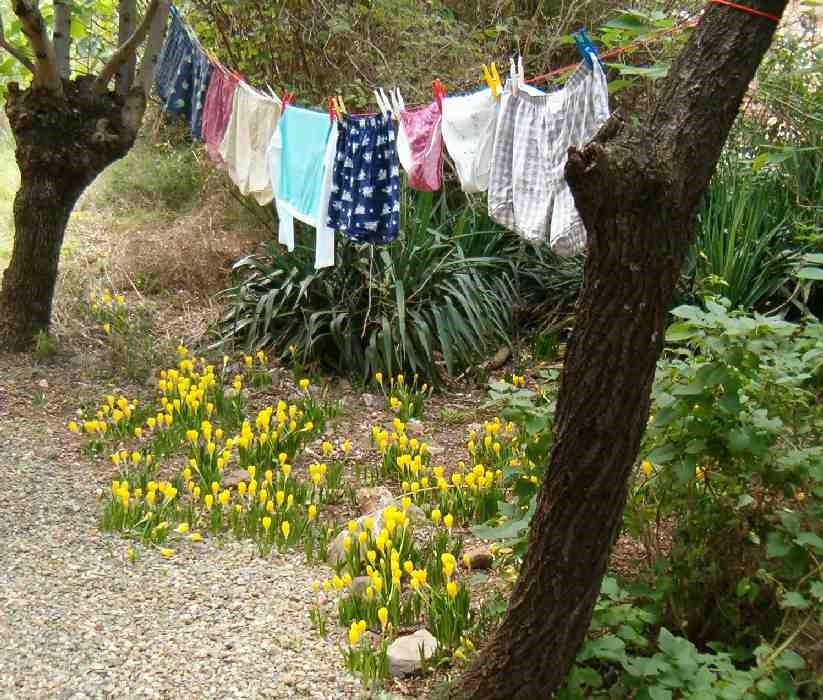
|
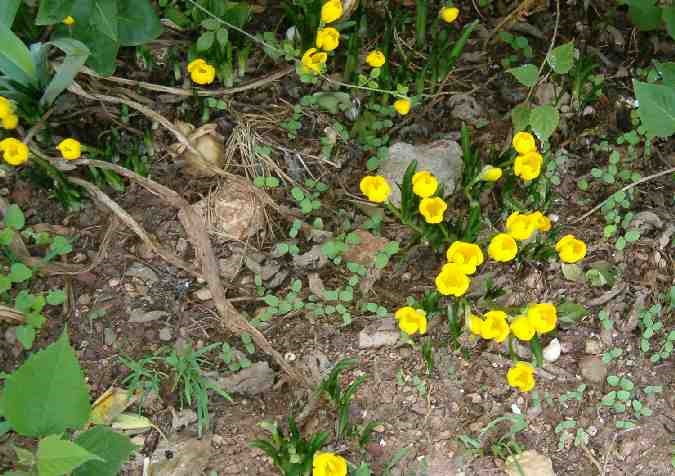 |
|
Cyclamen
hederifolium or neapolitanum flowers from
August. This species self seeds profusely, mostly in the
wrong spots. I put the seedlings - each with its darling mini tuber -
in a nice pot to plant out a year later. Pots are watered
daily so last year's seedlings are in leaf now, while those
in the garden will come into leaf much later. I have no
experience whatsoever with other cyclamen. I just planted Cyclamen coum **)
for the first time and have been trying to find
Cyclamen graecum
*) which supposedly grows in clefts in the rocks in Greece, so
why not here ...
*) got some in 2006. One flower in 2007, but
plenty of leaves later!
*) it flowered quite well in 2008, very first good
results.
|
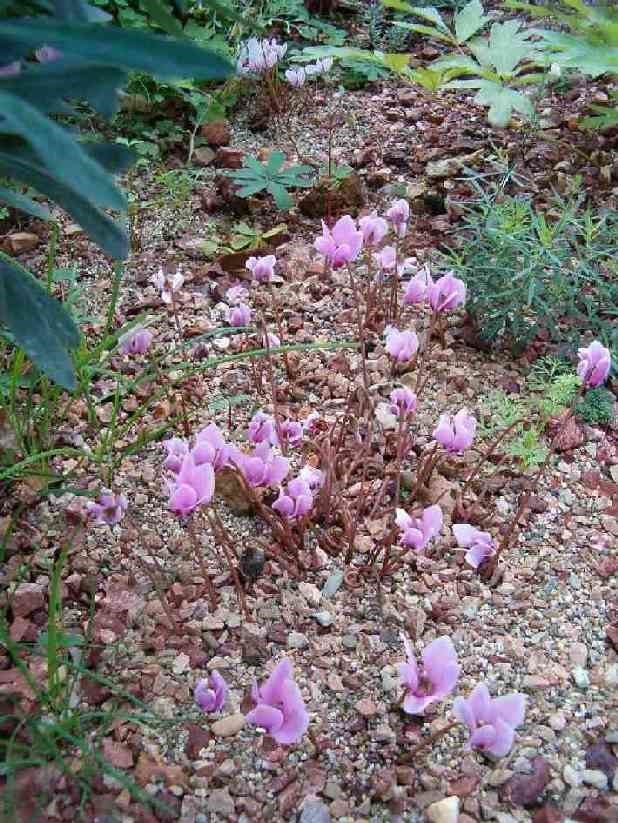
|
|
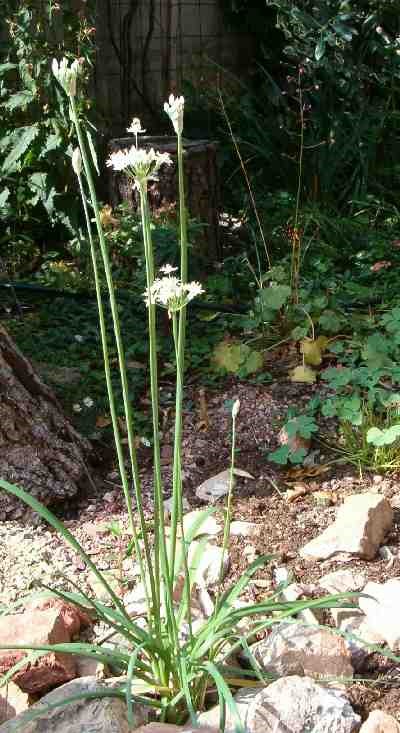
|
One
allium is in flower now (late summer): Allium tuberosum, sown two years ago.
I
am not good at sowing, French houses have no windowsills
usually and sowing outdoors is not always successful. But we
are going to have one balcony changed into a hothouse soon
...
This allium is known as Chinese
chives and seems to taste nice in a salad. I only have one
plant and shall not touch it for something worldly like
salad. The taste has a whiff of garlic in it. It is an
elegant allium and looks good against a dark background. I
once read that you should remove the flowers in its first
year (which I did). Good scent.
|
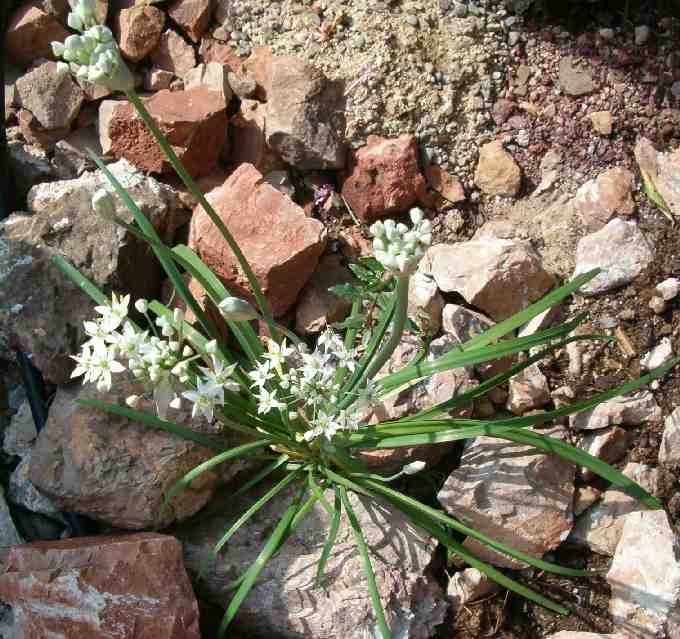 |
Other
alliums/allia?: Allium neapolitanum is a native. Its
white flowers in May are good cutting flowers. Allium roseum,
also growing wild here flowers a little later, shell pink, lovely.
Buy a few, if necessary and you will forever have them. Allium
flavum is surprisingly resistant to heat. They flower in
July. You must get close to see them well though as they are rather
small. Rita van der Zalm calls them: 'tiny, exploding fireworks,
over a thin, but firm stem', in her catalogue (in Dutch, sorry), a
well contrived description. On photos I love Allium caeruleum
as I do in reality, but I can't get them going. They flower in a
miserly way and the year after they have gone walkabout. All these
allium have since disappeared (2008), both in
the part that is regularly watered and the part
that is never watered.
But Allium ramosum does quite
well.
|
|
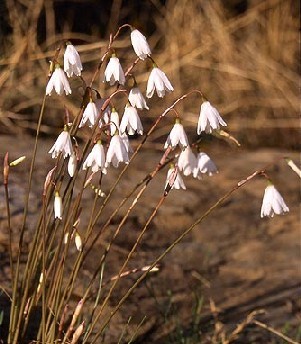
|
Photo stolen from the internet by one Juan Luis.
Leucojum autumnalis is attractive for those who like
'dainty', tiny hanging bells with some pink on the outside, no
taller than 15cms. It flowers from the end of August for
several weeks and produces quite a lot of seed which
germinates easily and will flower two years later.
It is a native of other Mediterranean countries like Spain and
Portugal. By now - 2006 - I find them all over the garden.
I just read that its name is being changed into Acis
autumnalis.
|
|
A native plant which many covet is Aphyllanthes
monspeliensis. A tuft of thin sprigs, somewhat like Festuca
glauca, but thicker, decorated with sky blue flowers in May.
During the flowering period they quite spectacular because of the
masses of flowers, but afterwards the plants are not all that nice
to look at. It is more or less impossible to transplant aphyllanthes.
You may succeed with very young seedlings but it is difficult to
find them. Seed is hard to come by as well, but once the plant has
settled in your garden it will spread itself readily. I cut the
tufts in late autumn to make them look better the year after.
For those who still happen to want to buy bulbs to enjoy next spring:
Crocus chrysanthus 'Cream Beauty',
which flowers quite early and is cream as expected, does very well
indeed. Crocus chrysanthus originates from Greece. The next one from
Croatia: Crocus tomassinianus 'Ruby Giant'
is a top choice in Holland but less successful here. A small tulip, Tulipa 'Little
Beauty', also does well. A darling little thing, rosy red
with a blue centre and no taller than appr. 20 cms. I Have seen both
'Cream
Beauty' and 'Little Beauty' in a large garden center in Béziers (from
the Netherlands!) the crocus at a reasonable price, the tulip rather
expensive. The tulip can be left in the ground, you don't have to
store it for summer.
There was something we called Abessinian gladioli scores of years
ago. Then the name was changed into accidantera and later
again into Gladiolus callianthus. I had them for years
in the Netherlands. I used to plant them in April, they would flower
from August onward and later, when they had completely turned brown
I would pull them up and store them, leaves and all, in a dustbin bag
close to the boiler for the central heating. They even produced
bulblets, called 'beads' in Dutch and every year I could give away
quite a few bulbs as I had so many!
I thought they would be really suitable for this climate, but no:
they start growing after the heat of August, come into a great deal
of leaf but flowers are scarce. |
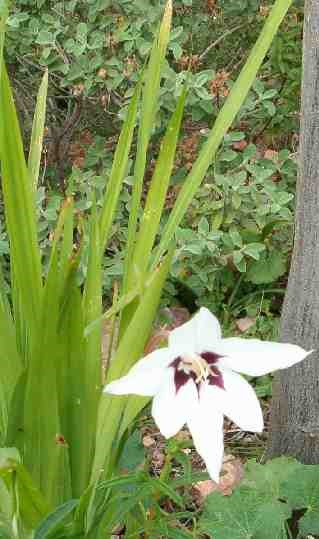
|
|
|
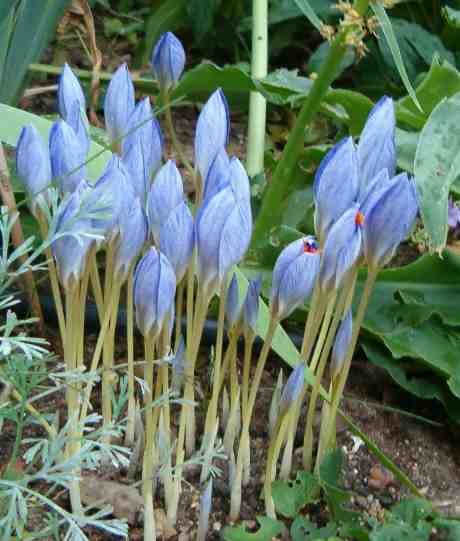
|
Now
that autumn is upon us I find autumn flowering crocus in the garden. This one is
Crocus speciosus 'Oxonian'
It grows quite easily. Crocus speciosus is found in the Krim
region.
Crocus
- from Greece - which I like a lot because it keeps well in the
rain unfortunately does not seem to like the south of France all that much.
Better in 2006 though. |
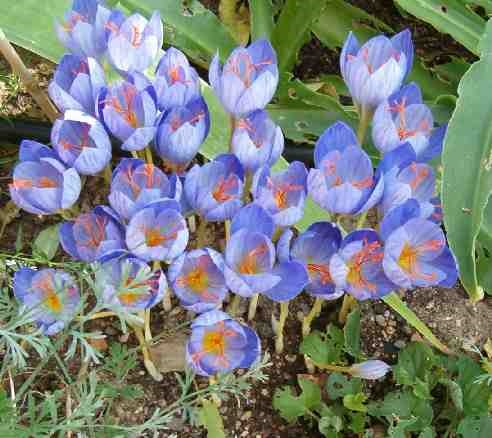 |
| 20th
January 2006 |
|
|
|
| Here
is to a whole new season!! We had our first day
of spring yesterday with temperatures rising to
app. 20 degrees! Wow. |
|
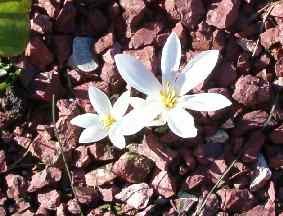
|
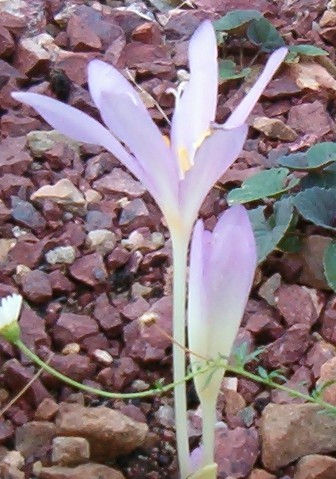
|
I was pleasantly surprised
by the appearance of two lovely colchiums:
Colchium hungaricum on the
left and c. laetum on the
right. C. laetum in spite of its happy
name is pretty, but the flowers last only
for a day or two. Longer in 2006. Laetum
is an autumn flowering type but
accidentally flowered in the spring of
this year.
As colchiums usually flower in autumn they
are quite interesting! |
|
Another early 'bird' is Narcissus
romieuxii from Marocco. It usually
flowers around Christmas, but December has
been too cold. It was actually the first
time I saw the flowers - we always visit
our homeland at Christmas - and discovered
they were yellow rather than cream as I
had expected them to be. Its leaves are
spriggish and quite long. They appear
around November. They grow to
approximately 12-15 cms.
2008: these are doing very well and they
multiply! |
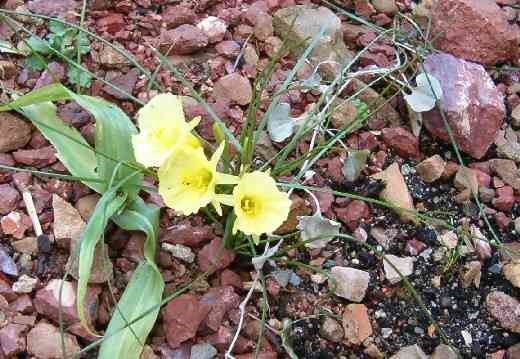
|
 |
I spent hours today on
the internet trying to find out the
exact name of the bright yellow
crocuses suddenly showing up. The
thing is you order things, plant
them and forget where you put what!
This is Crocus vitellinus,
from Turkey and Syria. Small, covered with feathery pale
brown markings outside which look
like someone has tried to erase them
and with a dark stem. I have
the book on bulbs by Martin &
Rix in a Dutch version. It mentions
this crocus in the index with the
number of the page and all, but it is
nowhere to be found in the book
itself!!! Nearby grows Crocus
korolkowii 'Kiss of spring'
but it does not do very well.
Korolkowii is from Pakistan. |
|
|
|
|
|
| 10th February today. It is still cold, but
sunny. Late afternoons are quite nice. Iris
danfordiae has made its appearance - good smell
if you don't mind going on your knees! - and the Crocus
'Cream Beauty' , one of my favourites, is
starting out as well. It did not do all that well in the
Netherlands, but is a prize here. |
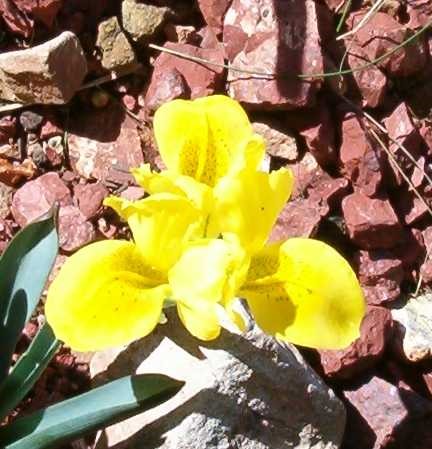
|
|
|
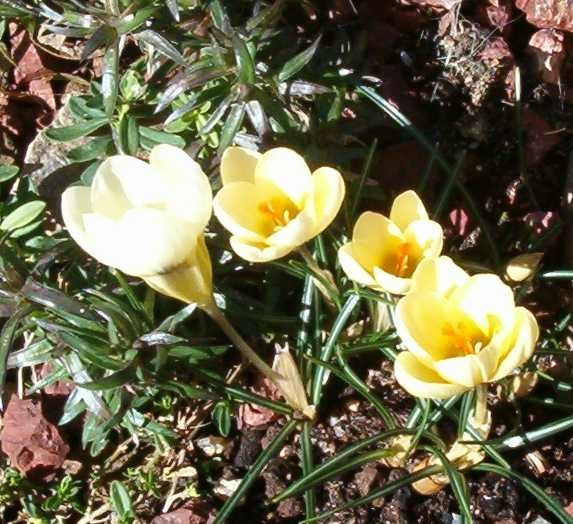
Crocus 'Cream Beauty' flowers quite early and
does really well here, one of the best!
Also - 17th February - the small blue irisses are starting: Iris
reticualata 'Cantab' is one I particularly like. Its
is not a bad idea to give them some fertilizer at this stage.
Something you use for indoor plants usually works quite
well.
2008: gradually disappearing
|
|
Muscari macrocarpum 'Golden Fragrance' started off at
the beginning of February. Today - 17th - it is in full flower and
will keep flowering for quite a while. It is my best find of 2005:
the flowers are quite big and have a subtle fragrance.
Where to find these small bulbs: see bulb list!
This one gets some seeds which are not too difficult to produce more
bulbs from. You need patience though.
|
|
|
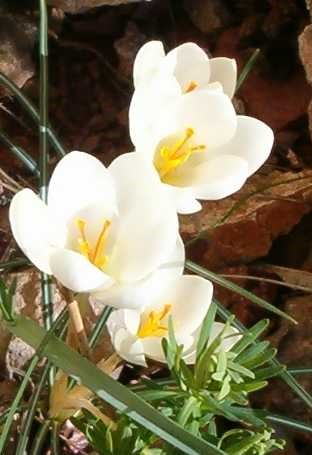
|
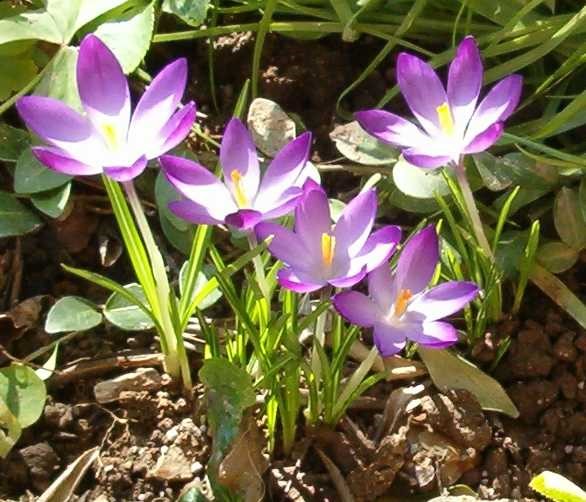 |
The white crocus on the left is one of the
first to flower. I do not know its name. Does anyone?
The purple one is Crocus tommassinianus 'Ruby Giant' ,
an excellent performer in the Netherlands, but not doing quite so
well here. Lovely though. |
|
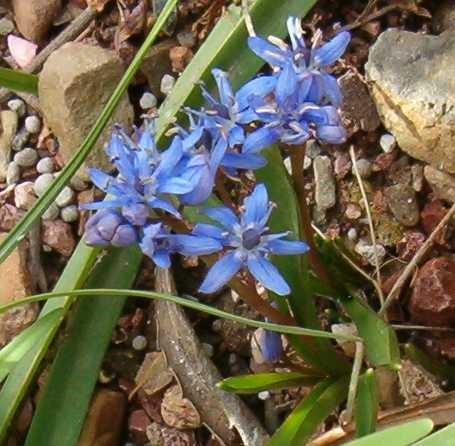 |
Scilla bifolia does
not perform as well as it does in Holland, but its lovely blue is irresistible.
Ipheion uniflorum grows
naturally in these parts. Its Dutch name is something like
'little old ladies'! Here they are blooming in the protection
of a warm wall, they will soon appear everywhere. Ipheion
"Rolf Fiedler' is of a more intense blue:
strongly recommended.
|
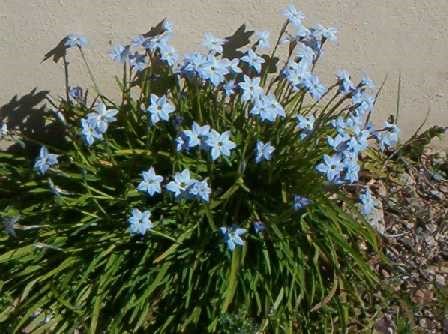 |
|
I once saw a picture of Oxalis massoniana in a book
(Bulbs for all climates, an issue of the Australian Women's Weekly
Garden Guides (1994), page 100) to which I immediately lost my soul.
Ever since I have been trying to find it and so I finally did, on
the internet, in South Africa. November 2004. (Photo below left)
I mailed the
supplier who told me to order in January and when I did they were
sold out. Like any other gardener I do have a lot of patience, so I
could wait another year. In December 2005 I was again advised to
order in January. Which I did. Jim replied he only had a few but he
would dig some up just for me. So I ordered some more bulbs a.o.
Oxalis cathara - which is a sort of must for
an oxalis freak living in Cathares' country - on the condition they
would be accompanying o. massoniana. One day I received glad
tidings: the package was on its was. I prepared my very best pot for
the coveted oxalis. A package decorated with colourful South African
stamps sporting birds and such duly arrived a few days ago. It did
not contain oxalis massoniana. I do have a lovely photo, pinched
from another website: Kellydale Nursery's in New Zealand. They do
not export bulbs!
I'll keep you informed!
Jim - quite a nice guy - sent them later. It took a year and a half
to get them to flower, but finally they did. They were white
... This oxalis has to have its feet wet when in flower, so
put the pot in a dish containing water. They will wither a little
later and can be kept completely dry during the hot summer months. |
|
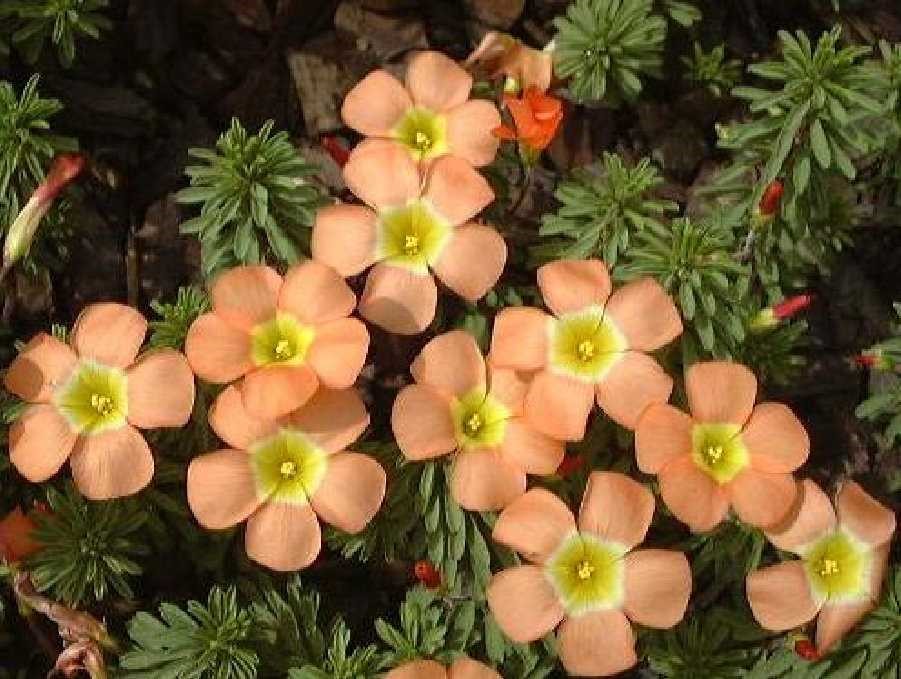 |
On the right: Ranunculus
ficaria 'Salmon's White', which I brought from
my garden in Holland. This pilewort is not as expansive
as the ordinary one and has large, creamy flowers. Recommended. For sale a.o. at Rita's.
The daffodil is my favourite:
Narcissus J.P. Milner. They do not perform
as they do in colder and wetter areas, but as this year
I have flowers, possibly because there has been so much
rain. |
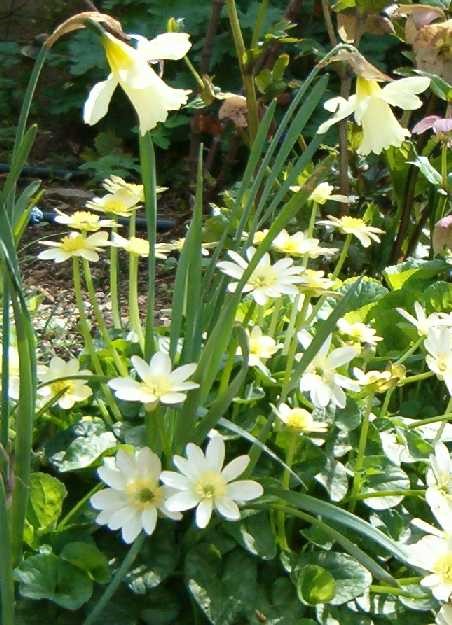
|
|
|
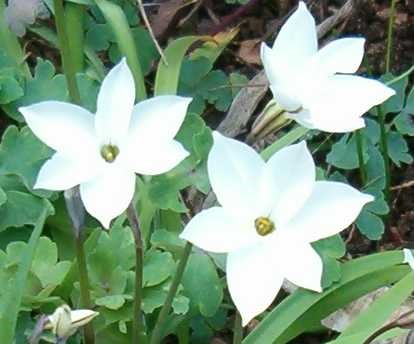 |

|
On the far left a white form of ipheion.
It has been given to me as being 'Albert Castillo' ,
but I am not sure about the name, as Albert should have more than
one flower to one stem (?).
The other is Gladiolus tristis which I find a real
gem. I should have bought 25, but they are expensive (for sale at bulb'argences.)
They are quite tall, 70 cms or so, very thin and have a delicious
perfume. Flowers in March/April. Watch out for caterpillars. |
| The thing is that you never expect
anything that grows well in a cool place like the Netherlands would
do well in the south of France as well. But there are some
surprises. This Tulipa 'Little Beauty' and what an
apt name! I have actually bought some at a local garden centre. But
they are sold by Rita as well. She describes their colour as being
thyrian purple, so if you always wondered about that colour: here it
is! |
|
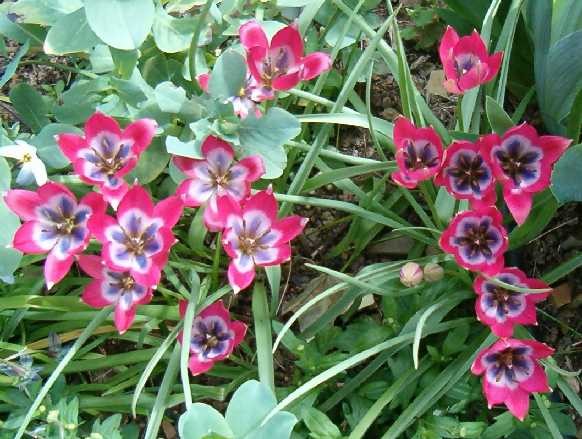 |
|
|
16th December Last night it
finally rained copiously so today I spread (dried) cow's dung. This I have to import
from the Netherlands. What do I find doing this job?: Muscari macrocarpum IN
FLOWER! Fortunately it flowers for at least two months so when I come back
in January it will still be there. It is easy to sow by the way though the
seeds are few. I shall have my garden covered in them in a few years time!
There was a bumblebee at work as well.
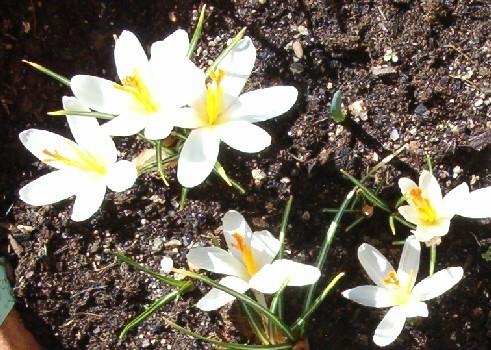 |
16th February 2007
Spring is here again so the crocuses are in flower. Crocus malyii
on the left and on the right Crocus tommasinianus
'Claret'. Malyii is not a very easy one to find. It was also
much smaller a year later. |
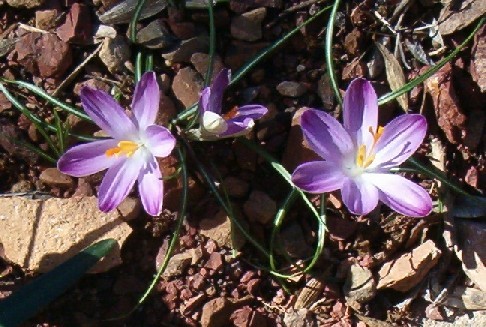 |
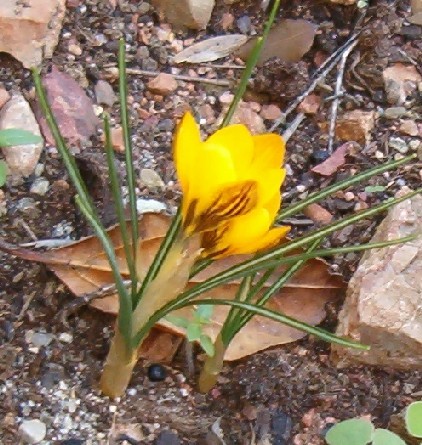 |
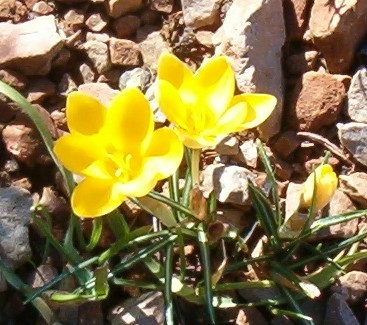 |
Two yellow ones: left, nicely decorated in fine brown
lines on the outside is Crocus fuscotinctus to the
right of that the better known 'Golden Bunch'. It is
a adorable small, copiously flowering crocus.
Contrary to what happens in the Netherlands: here yellow
crocuses are not eaten by the birds.. |
19th March: A
South African beauty. I ordered this one together with Oxalis
massonorum from Cape Seed not knowing what to expect.
(The oxalis finally flowered but turned out to be white, to my
dismay) Geissorhiza
radians is its name. I have to check its spelling
every time.
In S. Africa it flowers in September, so it has adapted nicely
to the seasons of the Northern hemisphere. Jim, who sells the
S. African bulbs, told me to put the pot in full sun and in a
dish of water during its flowering period. The same goes
for the oxalis. |
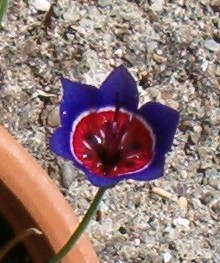
|
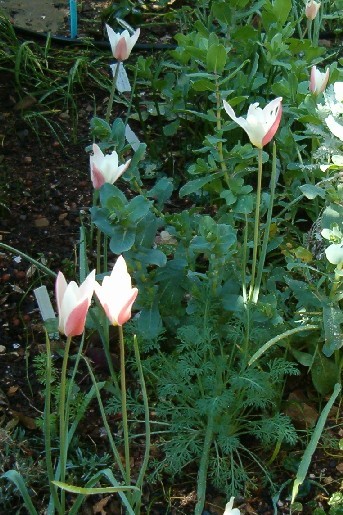
|
This little tulip is called Lady Jane and
I like her a lot; Her stamens are wine red. Lovely. We'll see
how she will behave in future.
(Smaller in 2008)
From: Vreeken. |
|
 |
This is something I don't understand at all. Fresias
in the worst possible spot, to wit a slope of gravel which burns in
summer, where they have hardly any water not to mention any fertilizer:
they flower like no other freesias in the garden. The books
speak of regular gifts of water, temperatures over 5° C and and
feeding once in a fortnight as soon as the leaves appear. But ...
2008 After a dry, dry summer
these freesias have completely disappeared!
|
| 17th April Now
that there has been good rain and the temperatures have risen
drastically spring suddenly came. Everywhere things in flower:
cistus, coronilla, aphyllanthes, all at the same time.
The beauty in the photo is Gladiolus
alatus. It is from South Africa. Just like geissorhiza it has
been outside all winter, in a pot. There was not much frost though
and whatever there was was not very bad, no more than -4.
Small bulbs may be ordered on the internet. Look under CAPESEED. With
a creditcard and a lot of patience (sometimes things do not go as
wanted , e.g. the wrong bulbs); on the other hand it is not very
expensive. |
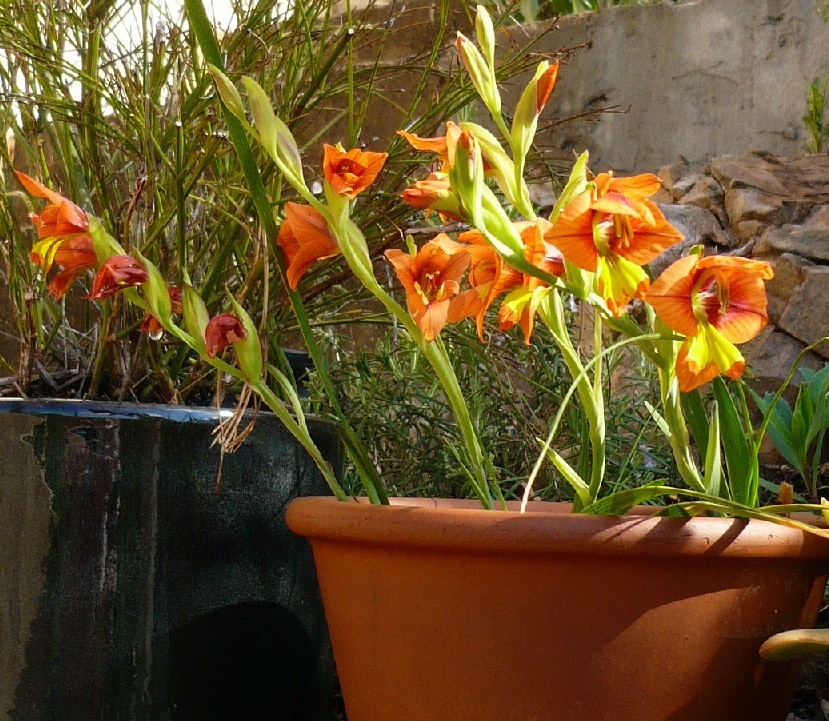
|
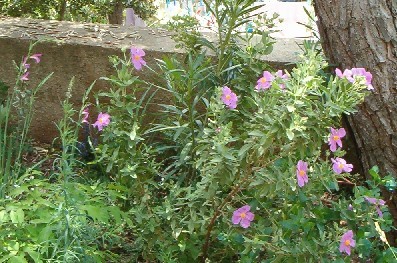 |
28th April Flowers
where-ever you look. Quite beautiful: cistus albus, a native bush,
combines prettily with Gladiolus communis. The latter
are soon finished, but self seed |
|
|
|
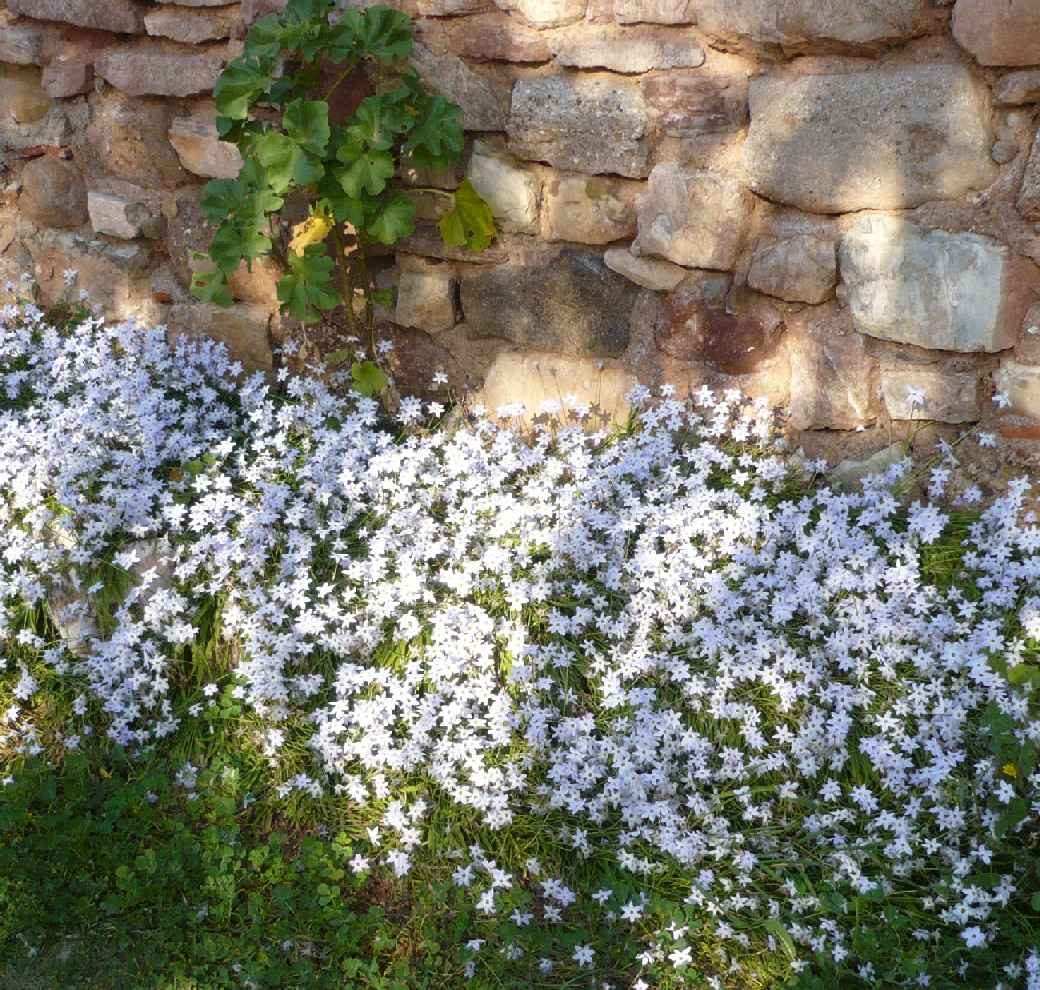
|
You come across all kinds of flowers when taking
a walk on the wild side: F.l.t.r.: not very many: Muscari
neglectum; rather common along
stretches of vineyards: Ornithogalum umbellatum
and where you find houses you may find Allium
neapolitanum. The allium
is quite a good cut flower. it will last some some 2 weeks. In
one our neighbours garden plenty of Ipheion uniflorum.
In Dutch they are called little old ladies. Photos: end
of March |
|
| 9th May When
I first came to live here I planted several small flowered
hippeastrum in the garden. Sometimes one comes into flower,
but whatever is the reason to get it going ...? I think this
one is called 'Veneto'. According to my big, green book it
also flowered in 2003 Quite a nice one, isn't it? |
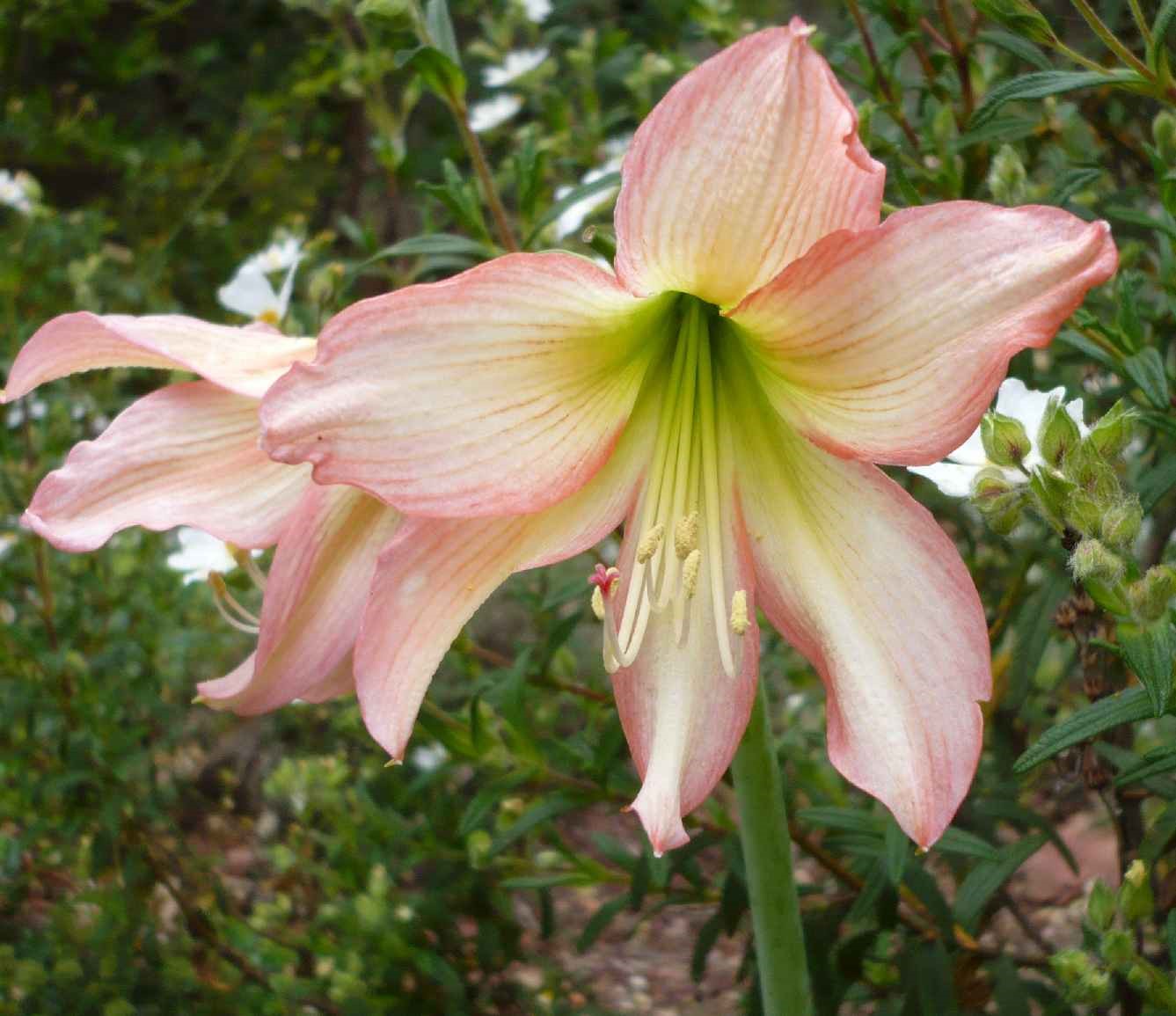
|
|
|
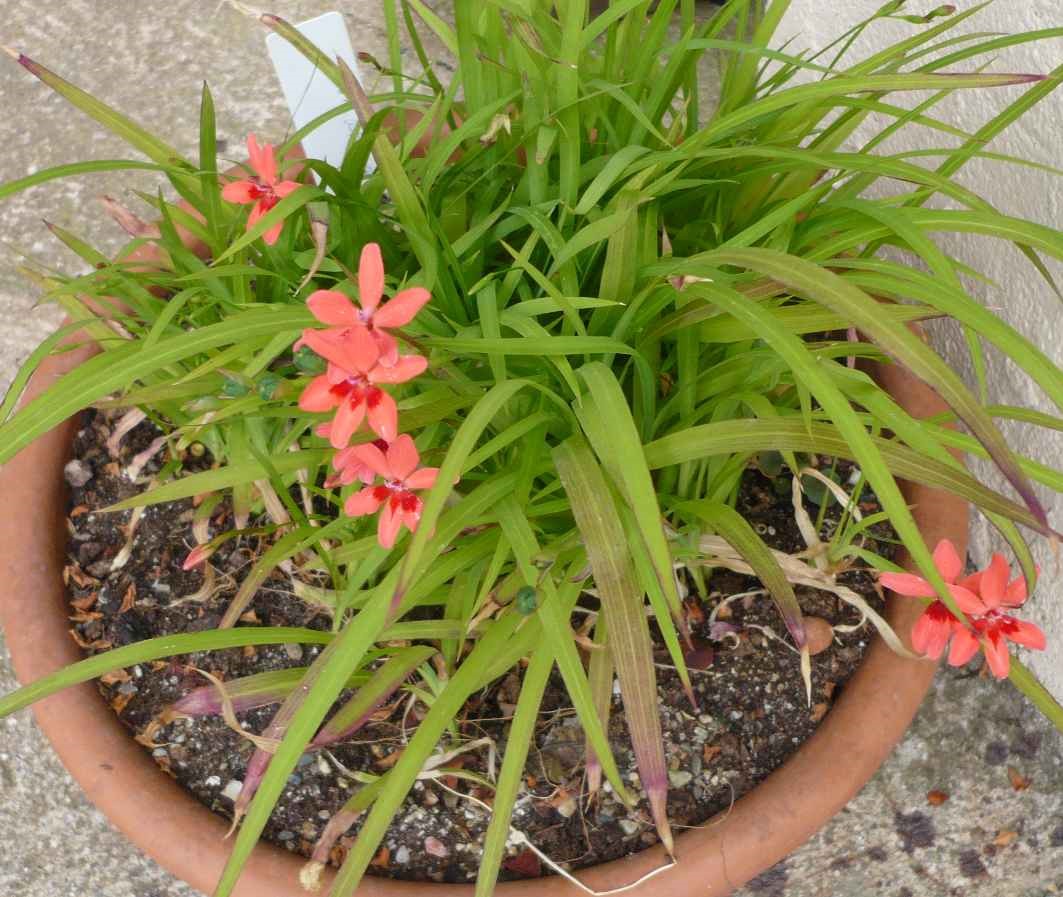
|
Lovely little thing and very easy: Anomatheca
laxa. In the garden it does not do very well, but it
grows really fast in a pot. Sowing is easy. They do grow among
the paving though! |
|
| 3 juni I
never wrote about this beauty before, in spite of the
fact that it is such a lovely species to use in these
parts: Tritteleia 'Corinna'. It has been
here for a few years already, but now suddenly I have
many more as the seedlings have matured! I see them
elsewhere as well! I bought them from Rita and to have
so many you have to be rich or patient! |
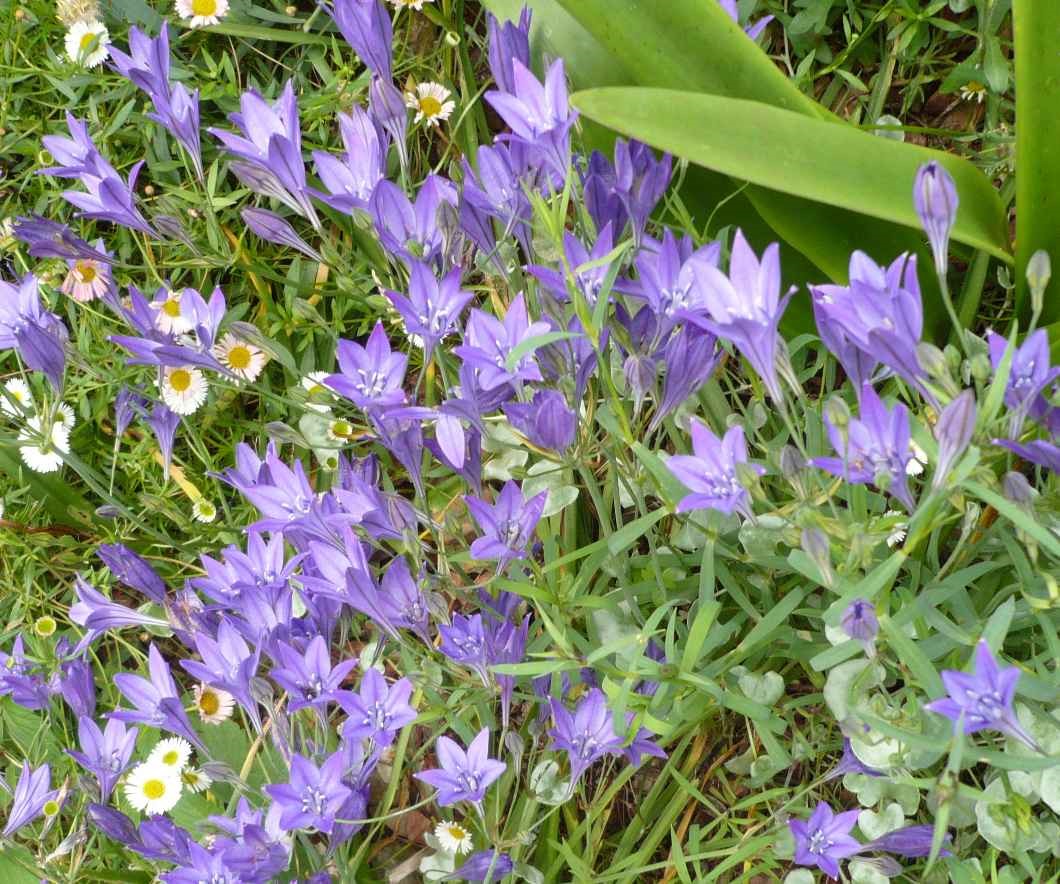 |
|
|
|
| top |
|
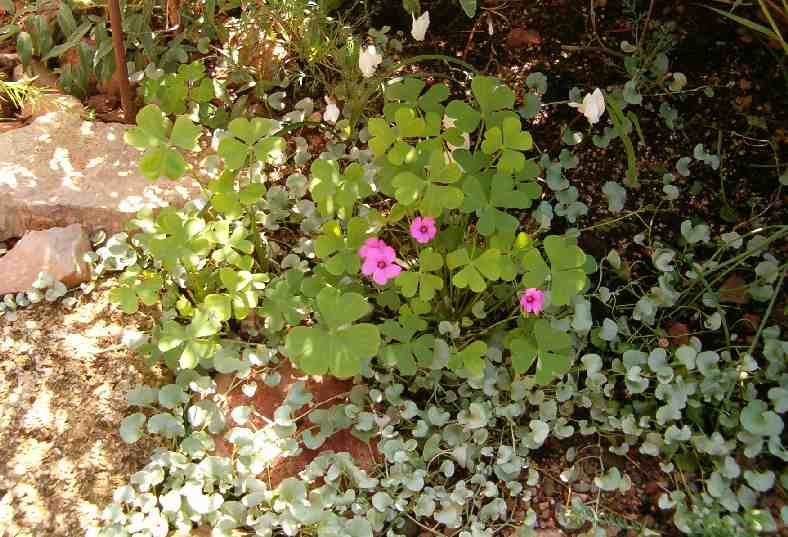
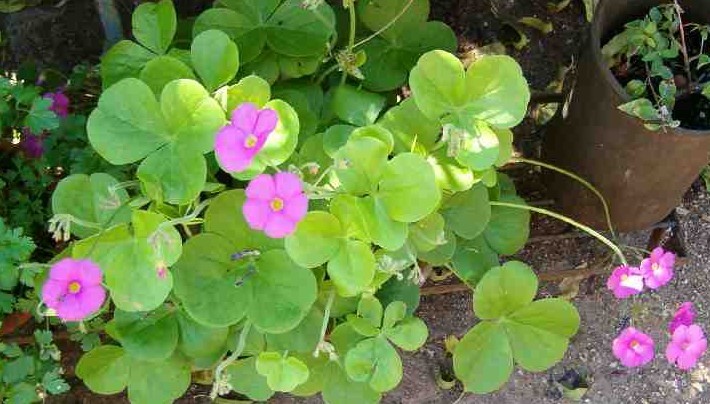

 Sternbergia
lutea
Sternbergia
lutea


